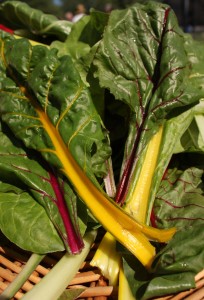
What is it and What do I do with it?
Swiss Chard is a member of the beet family along with table beets and sugar beets. It is rich in a variety of phytonutrients, minerals, and vitamins. A 100g serving includes 100% RDA of Vitamin C and 700% of Vitamin K.It is also a good source of Vitamin A, B-complex, copper, iron, magnesium, and manganese. This vegetable has a slightly bitter flavor with the leaves adding a unique flavor and texture to salads. It is more commonly prepared by sauteing, braising, and boiling, however there is nutrient loss with cooking. The bitterness will decrease with cooking.
A special note is due to the high level of Vitamin K individuals taking anticoagulants like warfarin (Coumadin) may want to consult with their doctor.
Storage
Like kale, the leaves will keep best with the base submerged in water or otherwise be kept in high humidity. In addition, the crisp leaves will begin to soften within a few days and are best eaten quickly.
Preparation
Trim about 1/4 – 1/2 off at the base, especially if not eaten the day of pick up. The two kale methods of removing the leaves from stem will work, however due to firmer veins in the leaves it is easier to fold and cut with a paring knife along the stem. Tearing or chopping the leaves work well. The latter is certainly more efficient. The stems should be cut between 1/4 to 1 inch in length, depending on the with of the stem. A good washing is easiest once prepare, but is important as these have a tendency to hold sand a soil.
Recipes
[catlist name=”Recipes” tags=”swiss-chard” orderby=title order=asc numberposts=-1]

One thought to “Swiss Chard”
I made a delicious swiss chard and garlic scape pesto this evening. It has a lot of garlic flavor. The recipe came from http://www.tablespoon.com
1/2 cup finely chopped garlic scapes
1 cup chopped swiss chard leaves
1/4 cup dry roasted almonds
1/2 cup freshly grated romano cheese
kosher salt, to taste
1/3 cup extra virgin olive oil
Blend together in a food processor and enjoy!
Comments are closed.